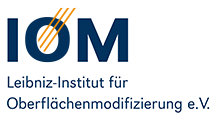Ultrafiltration membranes have proven to be highly effective in the purification of wastewater. The nanometer-scale pores are meticulously stabilized and maintained through the use of impregnating agents like glycerol, sodium azide, or water-alcohol mixtures. Without the incorporation of these impregnating agents, the membranes are susceptible to rapid drying during storage, transportation, or incorrect handling. Drying leads to the collapse of the pores, resulting in a significant loss of membrane performance, particularly in terms of permeation capacity.
In a project funded by the German Federal Ministry of Education and Research (BMBF), researchers from the IOM research department "Surfaces of porous membrane filters/innovative membrane materials" are working with their partner qCoat GmbH to develop a new type of multifunctional membrane coating that completely eliminates the need for additional and sometimes toxic impregnating agents. By modifying the membrane pores with a thin stabilizing layer, collapsing pores will be prevented. Using electron beam technology, these stabilizing layers can also be covalently bonded to the porous surface inside the membrane in a single step and entirely without the use of additional chemicals. Additionally, the stabilization layer shall exhibit a dual role by functioning synergistically as an antifouling coating.

